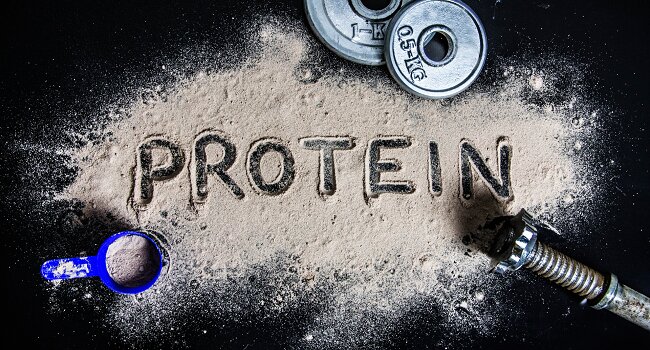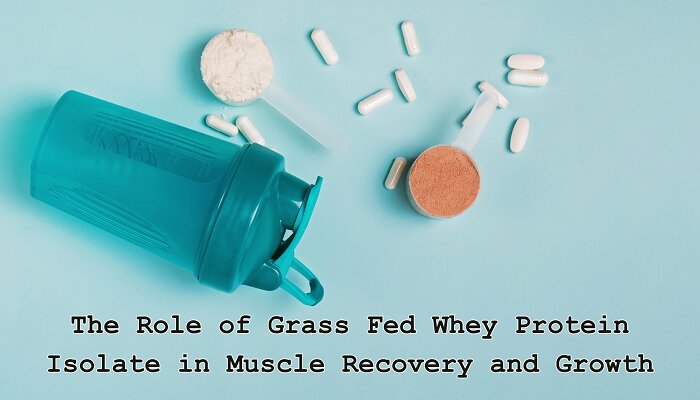Being an athlete, a physique builder or a fitness stage you are always in search of optimized ways of muscle recovery and growth. Thanks to protein being the important micro element, in the pursuit of this target whey protein has become a customary option.
On the contrary, the advent of grass-fed whey protein isolate surpasses the existing proteins in providing benefits, thereby giving it an edge over other kinds of whey protein. In this description, we are about to elucidate much concerning the role of grass-fed whey protein isolate in aiding muscle recovery and growth process.
Role of Protein in Muscle Building
When it comes to building and maintaining muscle, protein is an essential macronutrient. Protein is the building block of muscle tissue, providing the amino acids necessary for muscle protein synthesis. Without adequate protein intake, it is incredibly difficult to build new muscle mass or even maintain existing muscle.
Among the various protein sources available, whey protein has emerged as a popular choice for athletes, bodybuilders, and fitness enthusiasts. Whey protein is a complete protein, meaning it contains all the essential amino acids required by the body. It is also rapidly digested and absorbed, providing a quick influx of amino acids to the muscles.
Extensive research has focused on whey protein for its ability to support muscle growth and recovery. Studies have shown that consuming whey protein, particularly around workout times, can help increase muscle protein synthesis, enhance recovery, and improve body composition.
Role of Protein in Muscle Recovery and Growth
Enhancing Muscle Protein Synthesis
The main mechanism, which shows the way for grass fed whey protein isolate to build up muscles is by promoting muscle protein synthesis rate. Above, whey protein has been mentioned as a complete protein since it contains all the essential amino acids that are required for muscle growth and repair.
Although the micro nutrient profile of whey protein isolate that comes from grass fed cows can play a part in better muscle protein synthesis, the additional presence of essential nutrients which are in higher amounts could give this process a boost. The extra availability of amino acids, strengthened by the anti-inflammatory effects of compounds like CLA and omega 3, helps in making the environment properly aligned for muscle recovery and growth.
Improving Recovery from Intense Exercise
Extensive exercise can cause muscle decay despite the second-hand effects like the reduction of recovery and low performance level. Grass-fed whey protein isolate usually has anti-inflammatory benefits that most others don’t, and that could be the reason they are highly recommended by health professionals.
Compared to cows that receive only plant-based diets, the reality is that grass-fed whey protein isolates contain high levels of CLA and omega-3 fatty acids, which might help to maintain low inflammatory and oxidative stress levels within the muscle tissue. This can speed up the fixing and cutting off process, enabling athletes and fitness geeks to do away with damages more sharply and return back to their training programs.
Supporting Lean Muscle Mass Maintenance
Not only could grass-fed whey protein isolate contribute to muscle growth, it can also be considered one of the factors in preservation of lean muscle mass. Specifically speaking, it becomes all the more significant for people trying to shed the fat while retaining the lean muscle – for example, in the context of fat loss or body recomposition activities.
Consuming grass-fed whey protein isolate, with its rich nutrient content including an optimized amino acid profile and easily absorbed minerals, can help to sustain muscle mass when the person is calorically restricted or training with higher intensity that may impair muscle development. In order to gain such beneficial properties, athletes and people speaking about body composition and sports performance will most evidently benefit.
Incorporating grass-fed Whey Protein Isolate into Your Routine

Now that you understand the potential benefits of grass-fed whey protein isolate, the next step is to incorporate it into your dietary and supplementation routine.
Timing and Dosage
When it comes to getting the muscle recovery and growth maximization out of whey protein isolate produced from grass-fed cattle, timing and dosing make the world of difference. Now, the general advice is to consume unflavored and additive-free grass-fed whey protein isolate around your workout times, especially in your post-workout period in order to maximize the benefits.
The dosage effectiveness can differ depending on the factors of agitating conditions, such as body mass index, metabolic efficiency, and dietary protein content. As a rule of thumb, it has been recommended that one consume 20-30 grams of grass-fed whey protein isolate immediately after an exercise session, seeing as this is most optimal in terms of the mobilization of muscle protein synthesis and recovery.
Incorporating grass-fed Whey Protein Isolate into Your Diet
In addition to using grass-fed whey protein isolate as a supplement, you can also incorporate it into your daily diet in various ways. Here are some ideas:
- Add it to your post-workout smoothie or shake
- Use it in baked goods, such as protein bars or muffins
- Mix it into oatmeal, yogurt, or other breakfast options
- Incorporate it into your favorite recipes, such as pancakes or protein puddings
By thoughtfully including grass-fed whey protein isolate in your diet, you can ensure a steady supply of high-quality protein to support your muscle recovery and growth goals.
The Advantages of Grass-fed Whey Protein Isolate
Grass-fed whey protein isolate is derived from the milk of cows that have been exclusively fed a diet of grass, rather than the more common grain-based diet. This difference in feeding practices can have a profound impact on the nutritional profile and quality of the resulting whey protein.
Increased Nutrient Density
Cows eating grass produce milk with more beneficial nutrients like CLA, omega-3 fatty acids, and antioxidants. These nutrients also end up in whey protein isolate, making it healthier than grain-fed cow whey. CLA boosts body composition, reduces inflammation, and strengthens immunity. Omega-3s fight inflammation and support heart health.
Enhanced Absorption and Utilization
Whey protein from grass-fed cows is easier for the body to absorb and use. This is because it has more amino acids and fewer impurities. These cows eat grass, which makes their whey protein more easily absorbed. It also boosts amino acid usage. Additionally, grass-fed cows are less exposed to pollutants and toxins than grain-fed cows. As a result, their whey protein is cleaner and safer. This makes it more appealing to health-conscious consumers.
Conclusion
The quality of protein you intake, as you work towards muscle building and maintenance, which cannot be underestimated. The introduction of grass fed whey protein isolate (WPI) came up with a more advanced and maybe better alternative for the traditional whey protein. Grass-fed whey protein isolate offers the bonus of much improved nutrient profile, digestibility and anti-inflammatory effects and therefore it could be an outstanding source of a supplement for both your sports routine and overall diet.
By incorporating this premium, protein-rich food into your diet, you can access the advantages of better muscle recovery, growth, and repair, which will boost your fitness intensity and performance to the next level. Savor grass-fed whey protein isolate as one exciting way to see how a protein source can help you reach your objectives.
Frequently Asked Questions
How does the nutrient profile of grass-fed whey protein differ from regular whey?
Grass-fed whey protein is better because of its higher rate of nutrients including conjugated linoleic acid (CLA), omega-3 fatty acids, and antioxidants than the regular whey protein. Besides, this demonstrates that the grass-fed diet of cows coincides with nutrient-richer milk composition.
How much grass-fed whey protein isolate should I consume for optimal results?
The better amount of grass-fed whey protein isolate can differ according to factors, for instance, your body weight, the rate of activity you attend and the overall protein intake for your body. It is well known among the experts that about 20-30 grams of whey isolate from grass-fed proteins, must be consumed around workout time, particularly the post-workout period, to gain the maximum benefits for muscle recovery and development.
How can I incorporate grass-fed whey protein isolate into my diet?
There are several ways to incorporate grass-fed whey protein isolate into your diet:
- Add it to your post-workout smoothie or shake
- Use it in baked goods like protein bars or muffins
- Mix it into oatmeal, yogurt, or other breakfast items
- Incorporate it into your favorite recipes, such as pancakes or protein puddings


















